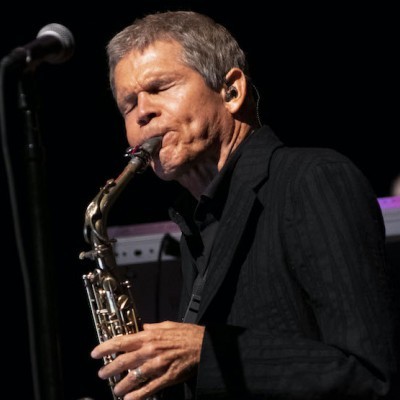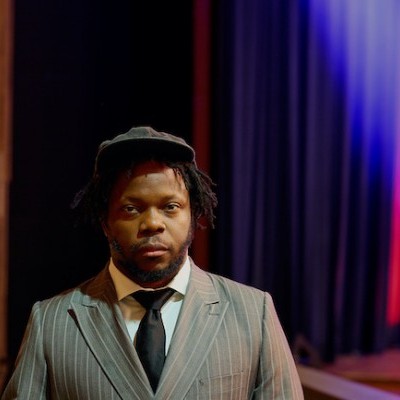Apr 2, 2024 12:59 PM
Saxophonist, Sonic Explorer Casey Benjamin Dies at 45
Casey Benjamin, the alto saxophonist, vocalist, keyboardist and producer who stamped his distinctive sounds on the…

“I try to strike just the right balance of paying tribute to the original and also injecting new life into the music,” says Myles Wright about his music inspired by classic video game tunes.
(Photo: Courtesy Myles Wright)Australian composer/arranger Myles Wright chose the repertoire for his latest self-produced release, Gamer, with particular care. He was adapting classic gaming soundtracks for jazz orchestra and these tunes, though utterly captivating, didn’t always translate easily into the modern jazz vernacular.
But “having written big band arrangements on and off for the last 20 years or so, I have developed a reasonable intuition as to what will work for a large jazz ensemble and what won’t,” the Perth musician wrote in an email correspondence with DownBeat.
By Wright’s own admission, his creative process tends to be “slow and steady,” and the album was a long time in coming. He first developed the concept for Gamer 22 years ago in response to an observation: Each time he listened to the music from the video games he’d played as a teenager, memories would come flooding back.
He took to arranging these indelible sonorities in 2017 and launched Gamer in January as a tribute to those early gaming compositions.
“It’s just great music,” he said.
On this, Wright speaks from a position of authority. Not only did he study jazz composition and arranging at Western Australian Academy of Performing Arts (graduating a few years ahead of bassist Linda May Han Oh), but he completed a master’s degree in studio jazz writing at the University of Miami’s Frost School. Later, during stints in Los Angeles and New York, he turned out two luscious big band albums: The LA EP and The Manhattan EP, respectively. And back in his native Australia, he continues to compose scores across genres for film, theater and television.
The 16 tracks on Gamer build deftly on this extensive experience — to a slightly different purpose. Where Wright’s previous work firmly established his bona fides as a composer, the new album shows off his skills as an arranger. In this regard, the task at hand — to revamp the looped earworms of 1990s computer games into contemporary art music — brought with it specific challenges.
The first was the nature of the original video soundtracks, written by innovative composers of differing musical backgrounds at a time when video scoring was still an emerging art form. Among these were Tim Follin, the exceptionally creative programmer who created the Plok! soundtracks, and Koji Kondo, who first started writing for Super Mario in 1985 and has remained the primary composer for the franchise ever since.
“Some of the music featured on Gamer was easy to adapt,” Wright said. “For example, some of the Plok! tracks — they already sound quite jazzy in their original form. Other soundtracks required a lot more work to bring into the jazz idiom. ‘Super Castlevania IV: Ending Theme’ is essentially an orchestral adagio work, which had to be transformed into a jazz ballad. “Prince Of Persia” wasn’t straightforward, either, having more of a Middle Eastern flavor in its original format.”
In adapting the randomly brilliant efforts of these early gaming composers, Wright’s formal training in orchestration proved essential. Especially, he explained, his understanding of the strengths and weaknesses of each instrument and how they might support the melodic action.
Thus, cheery flutes introduce the casual bounce of “Plok! Going Underground,” while a full-throttle horn section lends dynamic heft to “Plok! Going Home.” Simple piano voicings frame a lone trumpet on “Castlevania-IV-Ending,” the most contemplative track on the recording. And animated percussion — including Persian instruments — push the relentless motion of the four Prince of Persia selections.
Equally important, Wright’s first-hand experience of the technological advancements in gaming music gave him insight into not only the limitations under which the early video composers worked, but how he might adapt their music for a modern audience.
For instance, Kondo wrote the Mario Brothers “Overworld” theme — one of the most iconic in the gaming world — as a simple melody for single-channel audio, long before sampling, CD-ROMs and streaming allowed for greater complexity in video game music. To contemporize a theme like this, Wright might play with the form, add a countermelody, reharmonize the chordal structure, or alter the groove.
One hears how ingeniously Wright employs such devices on his reworking of Kondo’s jangly tune. First, he initiates the familiar melody at the top, dulcet in the reeds section, before introducing his own motivic ideas, fleshed out with rambunctious horns and a banjo tethered to the rhythm. He then escalates into full swing mode, modulating into vibrant improvisations, exciting band sections, and a triumphant outro. The tune stands on its own as a statement for big band — just as Wright had envisioned.
“I try to strike just the right balance of paying tribute to the original and also injecting new life into the music,” he said.
Long-standing video gamers will be pleased to note that the “Overworld” theme is just one of four Super Mario tracks on the album release — and that these album tracks are just some of the adaptations that Wright has on offer.
In fact, he pulled these cuts from a larger piece, an entire suite of cleverly arranged music from Super Mario that appears as a single entity only on Wright’s YouTube channel. There are other nostalgia-filled finds there, too, among the material that didn’t make it onto the album — such as his arrangements of themes from The Legend of Zelda and Gradius III, games that were developed, like Mario, in the mid-1980s.
Of note, too, among Wright’s live videos is the performance of his contemporary jazz piece “Pair Up: Duo For Marimba And Trombone,” from 2010.
Now that Gamer has wrapped, Wright says, he’ll return to composing, this time using “Pair Up” as the seed for a classical/jazz chamber ensemble featuring trombone and percussion.
The duo composition was “surprisingly well received, so I figure it’s high time I write more for this combination of instruments,” he said. “And writing for two or three instruments can be just as challenging as a larger ensemble, but in a different way. So I know I’ll continue to grow as a writer.” DB

Benjamin possessed a fluid, round sound on the alto saxophone, and he was often most recognizable by the layers of electronic effects that he put onto the instrument.
Apr 2, 2024 12:59 PM
Casey Benjamin, the alto saxophonist, vocalist, keyboardist and producer who stamped his distinctive sounds on the…

Albert “Tootie” Heath (1935–2024) followed in the tradition of drummer Kenny Clarke, his idol.
Apr 5, 2024 10:28 AM
Albert “Tootie” Heath, a drummer of impeccable taste and time who was the youngest of three jazz-legend brothers…

Sanborn’s highly stylized playing and searing signature sound — frequently ornamented with thrill-inducing split-tones and bluesy bent notes — influenced generations of jazz and blues saxophonists.
May 14, 2024 3:13 PM
David Sanborn, the star alto saxophonist who masterfully straddled the realms of straightahead jazz, R&B, rock and…

Henry Threadgill performs with Zooid at Big Ears in Knoxville, Tennessee.
Apr 9, 2024 11:30 AM
Big Ears, the annual four-day music celebration that first took place in 2009 in Knoxville, Tennessee, could well be…

“I’m also at a point in my life where I don’t feel like I have anything to prove, like at all,” Akinmusire says about his art.
Mar 26, 2024 12:45 PM
At the risk of oversimplifying and romanticizing the story, Ambrose Akinmusire came bursting on the jazz scene at the…